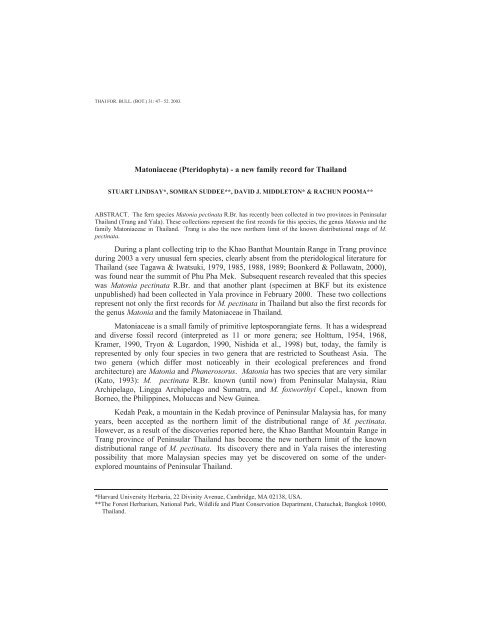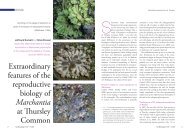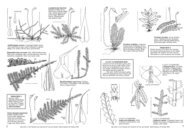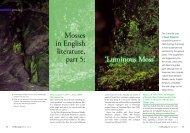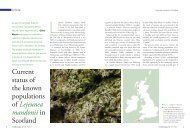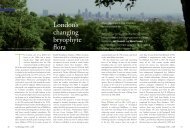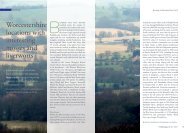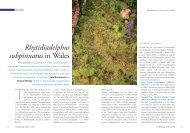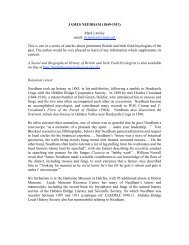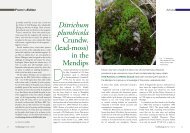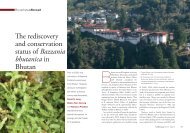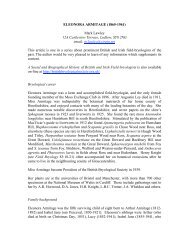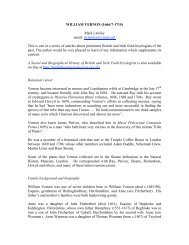Matoniaceae (Pteridophyta) - a new family record for Thailand ...
Matoniaceae (Pteridophyta) - a new family record for Thailand ...
Matoniaceae (Pteridophyta) - a new family record for Thailand ...
Create successful ePaper yourself
Turn your PDF publications into a flip-book with our unique Google optimized e-Paper software.
THAI FOR. BULL. (BOT.) 31: 47– 52. 2003.<br />
<strong>Matoniaceae</strong> (<strong>Pteridophyta</strong>) - a <strong>new</strong> <strong>family</strong> <strong>record</strong> <strong>for</strong> <strong>Thailand</strong><br />
STUART LINDSAY*, SOMRAN SUDDEE**, DAVID J. MIDDLETON* & RACHUN POOMA**<br />
ABSTRACT. The fern species Matonia pectinata R.Br. has recently been collected in two provinces in Peninsular<br />
<strong>Thailand</strong> (Trang and Yala). These collections represent the first <strong>record</strong>s <strong>for</strong> this species, the genus Matonia and the<br />
<strong>family</strong> <strong>Matoniaceae</strong> in <strong>Thailand</strong>. Trang is also the <strong>new</strong> northern limit of the known distributional range of M.<br />
pectinata.<br />
During a plant collecting trip to the Khao Banthat Mountain Range in Trang province<br />
during 2003 a very unusual fern species, clearly absent from the pteridological literature <strong>for</strong><br />
<strong>Thailand</strong> (see Tagawa & Iwatsuki, 1979, 1985, 1988, 1989; Boonkerd & Pollawatn, 2000),<br />
was found near the summit of Phu Pha Mek. Subsequent research revealed that this species<br />
was Matonia pectinata R.Br. and that another plant (specimen at BKF but its existence<br />
unpublished) had been collected in Yala province in February 2000. These two collections<br />
represent not only the first <strong>record</strong>s <strong>for</strong> M. pectinata in <strong>Thailand</strong> but also the first <strong>record</strong>s <strong>for</strong><br />
the genus Matonia and the <strong>family</strong> <strong>Matoniaceae</strong> in <strong>Thailand</strong>.<br />
<strong>Matoniaceae</strong> is a small <strong>family</strong> of primitive leptosporangiate ferns. It has a widespread<br />
and diverse fossil <strong>record</strong> (interpreted as 11 or more genera; see Holttum, 1954, 1968,<br />
Kramer, 1990, Tryon & Lugardon, 1990, Nishida et al., 1998) but, today, the <strong>family</strong> is<br />
represented by only four species in two genera that are restricted to Southeast Asia. The<br />
two genera (which differ most noticeably in their ecological preferences and frond<br />
architecture) are Matonia and Phanerosorus. Matonia has two species that are very similar<br />
(Kato, 1993): M. pectinata R.Br. known (until now) from Peninsular Malaysia, Riau<br />
Archipelago, Lingga Archipelago and Sumatra, and M. foxworthyi Copel., known from<br />
Borneo, the Philippines, Moluccas and New Guinea.<br />
Kedah Peak, a mountain in the Kedah province of Peninsular Malaysia has, <strong>for</strong> many<br />
years, been accepted as the northern limit of the distributional range of M. pectinata.<br />
However, as a result of the discoveries reported here, the Khao Banthat Mountain Range in<br />
Trang province of Peninsular <strong>Thailand</strong> has become the <strong>new</strong> northern limit of the known<br />
distributional range of M. pectinata. Its discovery there and in Yala raises the interesting<br />
possibility that more Malaysian species may yet be discovered on some of the underexplored<br />
mountains of Peninsular <strong>Thailand</strong>.<br />
*Harvard University Herbaria, 22 Divinity Avenue, Cambridge, MA 02138, USA.<br />
**The Forest Herbarium, National Park, Wildlife and Plant Conservation Department, Chatuchak, Bangkok 10900,<br />
<strong>Thailand</strong>.
48<br />
THAI FOREST BULLETIN (BOTANY) 31<br />
MATONIACEAE<br />
<strong>Matoniaceae</strong> C. Presl, Gefässbündel Farrn 32, t.6. 1847 [Gefässbündel Farrn 32, t.6. 1847<br />
was a pre-print of Abh. Königl. Böhm. Ges. Wiss. ser.5, 5(2): 340, t.6. 1848]; Diels in<br />
Engler & Prantl (eds.) Nat. Pflanzenfam. 4(194): 343–350. 1900; Bower, Ferns 2: 220–227.<br />
1926; Copel., Gen. Fil. 172–173. 1947; Holttum, Revis. Fl. Malaya 2: 58–60. 1954 (also 2:<br />
58–60, 2nd ed., 1968); Parris, Jermy, Camus, & Paul in Jermy, Studies on the flora of<br />
Gunung Mulu National Park, Sarawak 189. 1984; Kramer in Kubitzki, Fam. Gen. Vasc. Pl.<br />
1: 183–185. 1990; Kato, Fl. Malesiana ser. 2, 3: 289–294. 1998.<br />
Terrestrial or lithophytic. Rhizome: creeping, dorsiventral, dicyclic-solenostelic or<br />
tricyclic-solenstelic, and densely covered with shiny, pale-brown or orange-brown,<br />
multicellular, uniseriate hairs. Fronds: alternate on the dorsal side of the rhizome; erect or<br />
pendant; stipes slightly or very hairy at base (hairs identical to those on rhizome) but<br />
glabrous and shiny above; lamina pedate with pectinate pinnae, or alternately pinnate with<br />
pinnae consisting of resting buds or bud-derived leaflets and linear, simple or <strong>for</strong>ked<br />
pinnules; veins free or only weakly anastomosing in sterile portions, usually anastomosing<br />
in soriferous portions. Sori: on the underside of fronds, round or elliptic, in one row on each<br />
side of costule or midrib; indusia, peltate, deciduous, thick in central portion, membranous<br />
and inrolled in marginal portion; sporangia few, large, simultaneously maturing, in 1–3<br />
layers in a circle around receptacle; each consisting of a short thick stalk and a subglobose<br />
capsule with an incomplete oblique annulus. Spores: tetrahedral-globose, trilete, pale,<br />
surface granulate.<br />
Two genera, each with very distinctive frond architecture: Matonia R.Br. and<br />
Phanerosorus Copel. Only Matonia is known in <strong>Thailand</strong>.<br />
MATONIA<br />
Matonia R.Br. in Wall., Pl. Asiat. Rar. 1: 16, t.16. 1829; Hook. & Bauer, Gen. Fil. t.43.<br />
1840; Hook., Sp. Fil. 5: 285–286. 1864; Copel., Gen. Fil. 172. 1947; Holttum, Revis. Fl.<br />
Malaya 2: 59–60. 1954 (also 2: 59–60, 2nd ed. 1968); Parris, Jermy, Camus, & Paul in<br />
Jermy (ed.) Studies on the flora of Gunung Mulu National Park, Sarawak 190. 1984;<br />
Kramer in Kubitzki, Fam. Gen. Vasc. Pl. 1: 183–185. 1990; Kato, Blumea 38(1): 167–172.<br />
1993; Kato, Fl. Malesiana ser. 2, 3: 290–292. 1998. Type species: Matonia pectinata R.Br.<br />
Terrestrial. Rhizome: creeping, dorsiventral, tricyclic-solenostelic, densely covered<br />
with shiny, orange-brown, multicellular, uniseriate hairs. Fronds: alternate in two rows on<br />
the dorsal side of the rhizome; erect, stipe brown or chestnut-brown, hairy at base but<br />
glabrous and shiny above, much longer than lamina; lamina perpendicular to stipe<br />
(umbrella-like), pedate, symmetrical, consisting of a central pinna and, on each side of that,<br />
an equal number (5–13) of progressively shorter pinnae; pinnae pectinate, deeply lobed,<br />
linear, coriaceous; costae glabrous on top, glabrous or hairy underneath; pinna segments<br />
linear-oblong and obtuse or narrowly deltoid and acute, entire, with revolute margins, shiny<br />
on top, often glaucous and papillate underneath; veins <strong>for</strong>ming costal areoles, <strong>for</strong>ked, free or
MATONIACEAE (PTERIDOPHYTA) -A NEW FAMILY RECORD FOR THAILAND 49<br />
only weakly anastomosing in sterile portions of segments, always anastomosing in<br />
soriferous portions (sori centred on small circular veins fed by 5–9 radial veinlets). Sori: on<br />
the underside of fronds, round, usually 0–3 per segment (but occasionally 4 or 5), often<br />
distributed with a bias towards the basiscopic sides of segments; indusia hemispherical,<br />
peltate, deciduous, thick in central portion and membranous and inrolled in marginal<br />
portion; sporangia 5–10 in one layer arranged in a tight circle around a prominent,<br />
persistent, receptacle; capsules subglobose-polygonal with incomplete oblique annuli.<br />
Spores: tetrahedral-globose, trilete, pale, surface granulate.<br />
Two very similar species: M. pectinata R.Br. and M. foxworthyi Copel. Only M.<br />
pectinata is known in <strong>Thailand</strong>.<br />
Matonia pectinata R.Br. in Wall., Pl. Asiat. Rar. 1: 16, t.16 (illustrations of the holotype).<br />
1829; Hook. & Bauer, Gen. Fil. t.43 (illustrations of the holotype). 1840. Hook., Sp. Fil. 5:<br />
285–286. 1864; Bedd., Ferns Brit. India 2: 186, pl. 186. 1866; Bedd., Handb. Ferns. Brit.<br />
India 19 1883; Tansley & Lulham, Ann. Bot. (Ox<strong>for</strong>d) 19(76): 475–519, pl. 31–33. 1905;<br />
Copel., Sarawak Mus. J. 2(3): 388. 1917; Holttum, Revis. Fl. Malaya 2: 59–60. 1954 (also<br />
2: 59–60, 2nd ed. 1968); Kato, Blumea 38: 167–172. 1993; Kato, Fl. Malesiana ser. 2, 3:<br />
289–292. 1998. Type: Peninsular Malaysia, Malacca, Mt Ophir (present day Gunung<br />
Ledang, Johor), near the summit at ca.1200 m, 1815, Farquhar s.n. (holotype K-W, Wallich<br />
List no.184, seen on microfiche). Fig. 1.<br />
Rhizome: 4–6 mm in diam. and densely covered with shiny orange-brown hairs, 3–3.5<br />
mm long. Fronds: 1–4.5 cm apart, stipes 1–7 mm in diam. and 40–135 cm long; lamina<br />
approximately 20–50 cm diam., central pinna 15–38 cm long, 10–26 shorter lateral pinnae<br />
(i.e. an equal number (5–13), on each side of the central pinna); pinna segments up to 2 cm<br />
long and 4–7 mm broad at base, narrowly deltoid and acute and usually oblique and falcate.<br />
Sori and spores as in genus description above except that Thai specimens of M. pectinata<br />
have 5–8 sporangia per sorus (and most commonly 6).<br />
<strong>Thailand</strong>.— PENINSULAR: Trang [Yan Ta Khao District, Khao Banthat Mountain<br />
Range, near summit of Phu Pha Mek, 1200 m, 7 April 2003, D.J. Middleton, V.<br />
Chamchumroon, S. Lindsay, R. Pooma & S. Suwanachat 1992 (A, BCU, BKF, L)]; Yala<br />
[Betong District, Sangala Khiri Mountain Range, 1520 m, 23 Feb. 2000, C. Niyomdham, P.<br />
Puudjaa & S. Chonkunjana 6082 (BKF)].<br />
Distribution.— Peninsular Malaysia, Riau Archipelago, Lingga Archipelago and<br />
Sumatra.<br />
Ecology.— In <strong>Thailand</strong> and Peninsular Malaysia M. pectinata grows only in exposed<br />
areas or in relatively open scrub on or near the tops of isolated mountains at altitudes of<br />
750–2000 m. In the Riau and Lingga Archipelagos M. pectinata has also been found at sea<br />
level. M. pectinata is a thicket-<strong>for</strong>ming fern adapted to poor sandy soils. Throughout its<br />
range, M. pectinata often grows with other thicket-<strong>for</strong>ming ferns such as Dipteris conjugata<br />
Reinw., Pteridium aquilinum (L.) Kuhn and various Gleichenia and Dicranopteris species
50<br />
THAI FOREST BULLETIN (BOTANY) 31<br />
(Tansley & Lulham, 1905; Parris et al., 1984). Its main associates in <strong>Thailand</strong> are Dipteris<br />
conjugata (see photo on page 68 of Niyomdham, 2000) and Gleichenia microphylla R.Br.<br />
The gametophytes of M. pectinata are relatively large and long-lived and, like many<br />
“primitive” fern species, can produce multiple embryos (Stokey & Atkinson, 1952).<br />
Note.— The <strong>family</strong> and genus descriptions given above are based on specimens of<br />
<strong>Matoniaceae</strong> from throughout the <strong>family</strong>’s range but the description of Matonia pectinata is<br />
based solely on the <strong>new</strong> Thai material. It is important to remember that this <strong>new</strong> Thai<br />
material represents only two plants and to be aware that the one in Trang province has<br />
laminae that are particularly small (20–25 cm in diam., consisting of a central pinna 15–18<br />
cm long and 10–14 shorter lateral pinnae) and stipes that are particularly thin (1–3 mm<br />
diam.). The description of M. pectinata in Flora Malesiana (Kato, 1998) reports rhizomes up<br />
to 8.5 mm in diam., stipes up to 180 cm long and laminae up to approximately 75 cm in<br />
diameter. It remains to be seen whether plants this large will also be found in <strong>Thailand</strong>.<br />
ACKNOWLEDGEMENTS<br />
We would like to thank the National Geographic Society <strong>for</strong> financial support <strong>for</strong> this<br />
work. We would also like to thank Orathai Kerdkaew <strong>for</strong> the illustrations, and Voradol<br />
Chamchumroon and Suwat Suwanachat <strong>for</strong> their assistance in the field.<br />
REFERENCES<br />
Boonkerd, T. & Pollawatn, R. 2000. Pteridophytes in <strong>Thailand</strong>. Office of Environmental<br />
Policy and Planning, Bangkok, <strong>Thailand</strong>.<br />
Holttum, R.E. 1954 (2nd ed. 1968). A revised Flora of Malaya, vol. 2, Ferns of Malaya,<br />
Government Printing Office, Singapore.<br />
Kato, M. 1993. A taxonomic study of the genus Matonia (<strong>Matoniaceae</strong>). Blumea 38: 167–172.<br />
________. 1998. <strong>Matoniaceae</strong>. Flora Malesiana, Series II, 3: 289–294.<br />
Kramer, K.U. 1990. <strong>Matoniaceae</strong>. In: Kramer, K.U. & Green, P.S. (eds), The Families and<br />
Genera of Vascular Plants I: Pteridophytes and Gymnosperms, pp. 183–185. Springer-<br />
Verlag, Berlin, Heidelberg, New York.<br />
Niyomdham, C. 2000. Plants of Hala-Bala (title in Thai). Amarin Printing and Publishing<br />
Public Co., Ltd. Bangkok.<br />
Nishida, H., Yoshida, A. & Nishida, M. 1998. Permineralized matoniaceous fossils from<br />
the Cretaceous of Japan. J. Jap. Bot. 73: 26–34.<br />
Parris, B.S., Jermy, A.C., Camus, J.M., & Paul, A.M. 1984. The <strong>Pteridophyta</strong> of Mulu<br />
National Park. In: Jermy, A.C. (ed.), Studies on the flora of Gunung Mulu National<br />
Park, Sarawak, pp. 145–233. Kuching Forest Department, Kuching.
MATONIACEAE (PTERIDOPHYTA) -A NEW FAMILY RECORD FOR THAILAND 51<br />
Stokey, A.G. & Atkinson, L.R. 1952. The gametophyte and young sporophyte of Matonia<br />
pectinata R.Br. Phytomorphology 2(2 & 3): 138–150.<br />
Tagawa, M. & Iwatsuki, K. 1979. Flora of <strong>Thailand</strong> vol. 3, part. 1. Royal Forest<br />
Department, Bangkok.<br />
________. 1985. Flora of <strong>Thailand</strong> vol. 3, part. 2. Royal Forest Department, Bangkok.<br />
________. 1988. Flora of <strong>Thailand</strong> vol. 3, part. 3. Royal Forest Department, Bangkok.<br />
________. 1989. Flora of <strong>Thailand</strong> vol. 3, part. 4. Royal Forest Department, Bangkok.<br />
Tansley, M.A. & Lulham, R.B.J. 1905. A study of the vascular system of Matonia<br />
pectinata. Ann. Bot. (Ox<strong>for</strong>d), 19(76): 475–519.<br />
Tryon, A.F. & Lugardon, B. 1990. Spores of the <strong>Pteridophyta</strong>. Springer-Verlag, New York,<br />
Berlin, Heidelberg.
52<br />
THAI FOREST BULLETIN (BOTANY) 31<br />
Figure 1. Matonia pectinata R.Br.: A. frond; B. rhizome; C. part of pinna with 4 intact sori; D. part of pinna<br />
showing the venation around one sorus (top segment) and under another (middle segment; sorus<br />
removed). A from C. Niyomdham et al. 6082 (BKF), B–D from D.J. Middleton et al. 1992 (BKF). Drawn<br />
by O. Kerdkaew.


